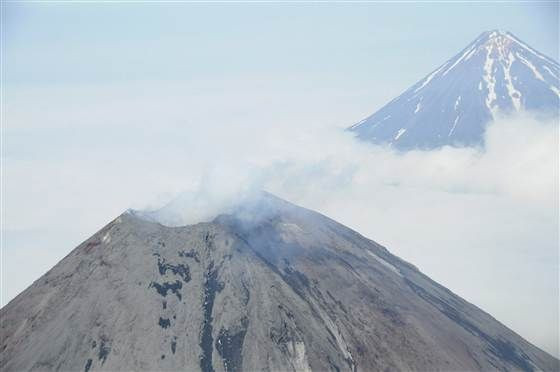
Mount Cleveland, one of Alaska's 90 active volcanos, has been experiencing low-level eruptions since Saturday. Since that time, the 5,676 foot volcano has experienced three explosions and started emitting a continuous plume of ash, steam, and gas in an area important to air traffic. So far, the plume from Cleveland's crater has only reached about 15,000 feet into the atmosphere, too low to cause damage to higher-flying jet airliners. "Once it gets to about twice that, we get really worried," said Rick Wessels, a U.S. Geological Survey geophysicist at the Alaska Volcano Observatory.
In the wake of the volcano's newest activity, the Federal Aviation Administration has reportedly chosen to re-route some air-traffic north of the site as a precautionary safety measure. A major eruption would reportedly lead to significant aviation risk, as the location of the volcano falls beneath a significant aviation route between Asia and North America.
The volcano has been showing more signs of activity since the summer of 2011, when it began oozing lava and causing lava domes to form at the crater, allowing pressure to build inside the peak. There have been about 20 to 25 sporadic explosions since this has started to occur; but Saturday's explosions was a new turn of events in the volcano monitoring.
"We haven't seen a phase like this where we've had multiple explosions," Wessels said.
The National Weather Service warns that if the eruptions become stronger, mariners are advised to avoid the area. Scientists have been put on around the clock duty to track Cleveland's activities.
"It's got us all paying attention. We're not sure if it will escalate or do what Cleveland does, which is to settle down after small explosions," he said.
Cleveland volcano occupies about half Chuginadak Island, located about 940 miles (1,500 Km) southwest of Anchorage. The island itself is uninhabited and, because of its remoteness, the volcano does not have a local seismic monitoring network. In order to observe it, Alaska Volcano Observatory scientists rely on satellite data, signals from a different volcano about 50 miles away, eyewitness reports, and infrasound detection, which "hears" low-frequency sounds below the range of human hearing.
© 2025 Latin Times. All rights reserved. Do not reproduce without permission.




